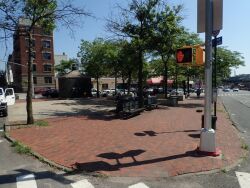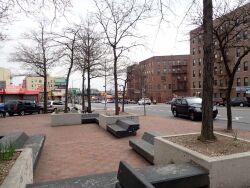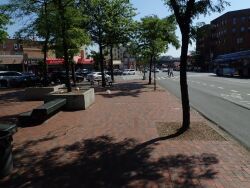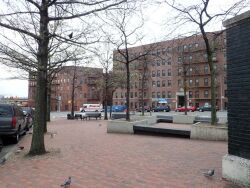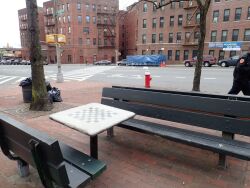Bryant Triangle
Bryant Triangle
Although some believe that this triangle and the adjacent avenue are named for Bronx Revolutionary War hero Captain Bryant, they are more likely named in honor of William Cullen Bryant (1794-1878), distinguished poet, journalist, and abolitionist, as well as a key figure in the organization of the Republican Party. Several streets surrounding Bryant Triangle are also named for American poets including Whittier, Longfellow and Drake.
Born in Cummington, Massachusetts, William Cullen Bryant moved to New York City in 1825, and became the editor of several newspapers including the New York Review, the New York Times, and the New York Evening Post, of which he became co-owner. As a poet, Bryant’s primary theme was the celebration of nature. Bryant was not only a master of words, but also a passionate proponent of many civic causes, including the movement to establish green spaces throughout the city. In championing the creation of Central Park, Bryant faced stiff opposition. The Journal of American Commerce claimed the cost of construction would be too great for the average taxpayer to bear. To this, Bryant responded, "Every investment of capital that renders the city more healthy, convenient, and beautiful, attracts both strangers and residents, and leads to a liberal patronage of every department of trade.” William Cullen Bryant is also the namesake of Manhattan’s Bryant Park, located between Fifth and Sixth Avenues, from 40th to 42nd Streets.
This park serves as a vital link to the Catskill Water Supply System. By the year 1907, the Croton System (the first major aqueduct system of its kind in the New York area) had proven to be insufficient for all five boroughs, and construction began on the Catskill Water Supply System. By 1917, the system was operational. In 1928, the Department of Water Supply, Gas and Electricity placed a small structure on the site. Although housing a small valve chamber, the main runs several hundred feet below the park grounds. Today, the water supply for New Yorkers in all five boroughs comes from three different systems, the Croton, Catskill and Delaware.
NYC Parks acquired this plot of land, bounded by Bryant Avenue, East 167th Street, and Westchester Avenue, through condemnation on January 15, 1893. In various eras, Bryant Avenue was known by other names including Walker Street, Hunter Street, and Oostdorp Street. In 1940, this triangle was named to honor World War I hero, Edward T. Hayes. On February 2, 1997, NYC Parks renamed it Bryant Triangle.
Check out your park's Vital Signs
Clean & Safe
Green & Resilient
Empowered & Engaged Users
Share your feedback or learn more about how this park is part of a
Vital Park System

